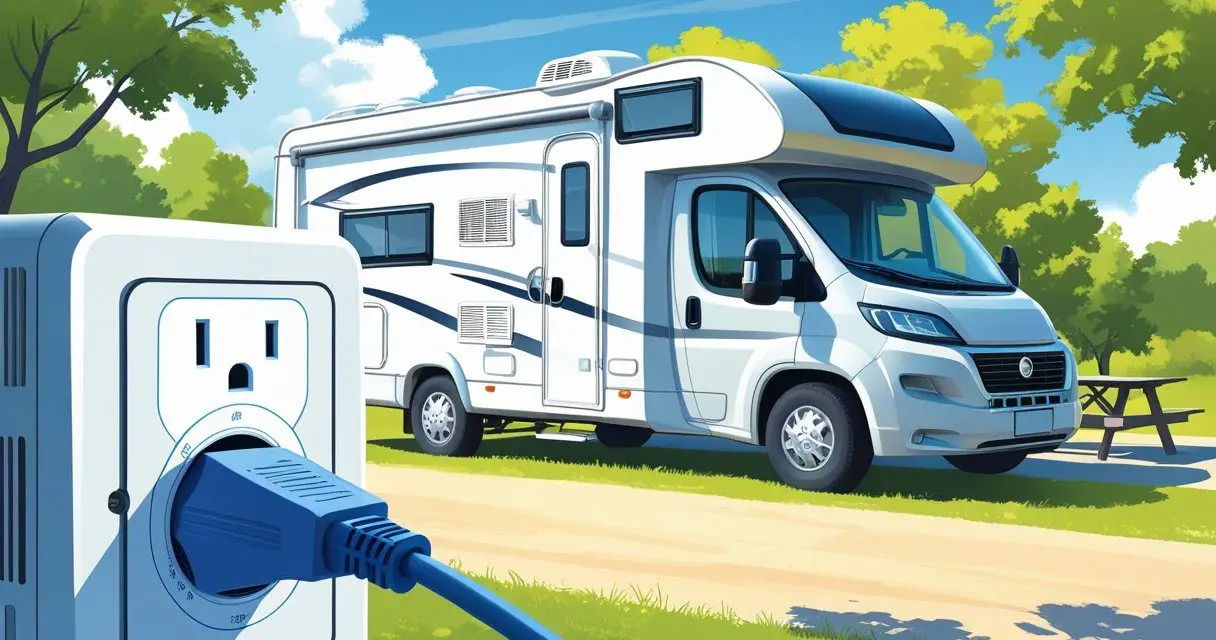Would you like to save this article?
Running your RV air conditioner on a standard 110-volt outlet is possible, but it comes with limits you need to understand.
Most RV AC units can run on 110 volts, but the circuit must provide enough amperage to handle the power draw without tripping breakers.
Knowing how much power your unit uses will help you avoid frustration and protect your electrical system.
Plugging into a household outlet may seem simple, but an RV air conditioner often pushes the limits of a 15-amp circuit.
Startup surges can cause problems if the wiring or breaker isn’t rated high enough.
That’s why paying attention to your setup matters before you flip the switch on a hot day.
If you want to keep cool without damaging equipment, you’ll need to look at safe ways to power your AC.
Some setups work fine with a 110 outlet, while others may require a stronger power source or backup options like a generator.
Key Takeaways
- Running an RV AC on 110 volts is possible if the circuit can handle the load
- Power draw and startup surges can trip breakers on standard outlets
- Safe operation depends on matching your AC needs with the right power source
Can I Run My RV Air Conditioner on 110 Volts?
You can run many RV air conditioners on a 110‑volt supply, but the setup depends on the size of your unit, the amperage available, and the way your RV power cord connects to the outlet.
The main factors to consider are voltage compatibility, circuit capacity, and the risk of overloading your system.
Standard RV AC Voltage Requirements
Most single RV air conditioners are designed to run on 110–120 volts, which matches common household outlets and many campground hookups.
These units usually draw between 12 and 16 amps when running, with a higher surge at startup.
Larger RVs with multiple air conditioners often require 220 volts or a 50‑amp hookup to handle the load.
A single 20‑amp circuit may support one 13,500 BTU unit, but it won’t reliably power two units at once.
RV AC power use is often measured in watts:
| Voltage | Amps | Watts (approx.) | Typical Use Case |
|---|---|---|---|
| 110V | 15A | 1,650W | Single rooftop AC |
| 110V | 20A | 2,200W | Larger single AC |
| 220V | 15A | 3,300W | Dual AC setups |
Knowing these numbers helps you match your RV air conditioner to the right power supply without stressing the system.
Direct Connection to 110V Outlets
You can plug your RV power cord into a standard 110‑volt household outlet with the right adapter.
However, most home outlets are on a 15‑amp circuit, which leaves little room for other appliances.
A 20‑amp circuit gives you more breathing room but still may be tight during startup surges.
When connecting directly, use a heavy‑duty extension cord rated for RV use.
Light‑duty cords can overheat and cause voltage drops, which strain your air conditioner.
Keep cords as short as possible to reduce resistance.
If your RV has a 30‑amp plug, you’ll need a 30‑to‑15 amp adapter to connect to a standard outlet.
This setup works for short runs but is not ideal for long‑term use, especially in hot weather when the AC runs constantly.
Potential Risks and Safety Concerns
Running your RV air conditioner on 110 volts comes with several risks.
The biggest issue is tripping breakers when the startup surge exceeds the circuit’s limit.
A 13,500 BTU unit can pull more than 15 amps for a few seconds at startup, which is enough to overload a household outlet.
Another concern is overheating wires and cords.
If your extension cord or adapter is not rated for the load, it can overheat and create a fire hazard.
Always match the cord gauge to the amperage draw of your RV air conditioner.
Voltage drops also reduce cooling efficiency.
If the AC doesn’t get enough power, it may run hotter, cycle poorly, or even damage the compressor.
Using a soft start device can help lower startup demand and reduce strain on the circuit.
Avoid running other high‑draw appliances like microwaves or space heaters on the same 110‑volt circuit as your AC.
Sharing the load increases the chance of tripping breakers or damaging your RV’s electrical system.
Power Requirements for RV Air Conditioners
An RV air conditioner needs enough electrical supply to handle both its starting surge and its continuous running demand.
The size of the unit, the available outlet, and the circuit capacity all determine whether it can safely run on 110 volts.
Wattage and Amperage Needs
Most RV air conditioners fall in the 13,500 to 15,000 BTU range.
These units typically require about 1,500–2,000 watts to run.
On a 110-volt outlet, that equals 13–16 amps of current.
A standard household outlet usually provides 15 amps.
This means your AC will take up almost the entire circuit by itself.
If the circuit is shared with lights, appliances, or chargers, you risk tripping the breaker.
Larger RV air conditioners or multiple units may need more power than a single 110-volt outlet can provide.
In those cases, a 30-amp or 50-amp RV hookup is required.
Always check the data plate on your AC unit to verify its exact wattage and amperage needs.
Starting vs. Running Power
Air conditioners draw a much higher load when the compressor first turns on.
This is called the starting wattage or surge.
For many RV units, the surge can be 2–3 times higher than the running watts.
For example:
| Condition | Typical Watts | Typical Amps (at 110V) |
|---|---|---|
| Starting | 3,000–3,500 | 27–32 |
| Running | 1,500–2,000 | 13–16 |
This short burst is what often trips a breaker on a household circuit.
Once the compressor is running, the draw drops back down to the normal level.
Some owners install a soft start device to reduce the initial surge.
This can make it easier to run an RV AC on a 20-amp household circuit without overloading it.
Impact on Household Circuits
When you plug into a home outlet, you usually connect to a 15-amp or 20-amp circuit.
A 20-amp circuit provides a little more headroom but still leaves very little extra capacity once the AC is running.
If other devices share the same circuit—like a refrigerator, microwave, or power tools—the total load can exceed the breaker rating.
This leads to tripped breakers or overheated wiring.
To avoid this, use a dedicated circuit with no other appliances connected.
A heavy-duty extension cord rated for 20 amps is also important to prevent voltage drop.
Using Generators to Run RV AC on 110
You can run an RV air conditioner on 110 volts with the help of a properly sized generator.
The type of generator, its power rating, and whether it uses inverter technology all affect how well it can handle the electrical load.
Types of Generators for RVs
Generators for RVs generally fall into two main categories: portable generators and inverter generators.
Portable generators are often larger, heavier, and less expensive.
They can produce high wattage, which makes them suitable for powering larger RV air conditioners.
Inverter generators are smaller, lighter, and usually quieter.
They produce cleaner power, which is safer for sensitive electronics like laptops and TVs.
Many RV owners prefer them because of their fuel efficiency and reduced noise levels.
If you only need to run your air conditioner and a few small appliances, an inverter generator is often enough.
For larger RVs with multiple air conditioners or heavy electrical loads, a larger portable generator may be required.
Sizing a Generator for Air Conditioning
The size of the generator you need depends on the starting watts and running watts of your RV air conditioner.
A typical 13,500 BTU unit may need around 2,800–3,000 watts to start and 1,500–2,000 watts to run.
A 15,000 BTU unit often requires even more.
You should also account for other appliances you want to run at the same time.
For example, a microwave, refrigerator, or coffee maker can add several hundred watts each.
Here’s a simple breakdown:
| AC Size (BTU) | Starting Watts | Running Watts | Recommended Generator Size |
|---|---|---|---|
| 13,500 | 2,800–3,000 | 1,500–2,000 | 3,000–3,500 watts |
| 15,000 | 3,200–3,500 | 1,600–2,200 | 3,500–4,000 watts |
Choosing a generator with extra capacity helps prevent tripped breakers and keeps your system running smoothly.
Inverter Generators vs. Portable Generators
Inverter generators are popular for RV use because they are compact, fuel-efficient, and produce stable power.
They adjust engine speed to match the load, which reduces fuel use and noise.
This makes them ideal if you camp in places with noise restrictions or want longer run times on a tank of fuel.
Portable generators often provide more raw power at a lower price.
They are better suited for larger RVs with multiple air conditioners or heavy appliance use.
However, they are usually louder and less efficient.
If you only need to power one AC unit and a few electronics, an inverter generator is usually the best choice.
If you need to run two AC units or a wide range of appliances at once, a larger portable generator may be necessary.
Alternative Power Solutions for RV AC
You can power your RV air conditioner without relying only on shore power or a generator.
Several systems, including battery banks, solar panels, and off-grid setups, can provide the electricity needed to keep your RV cool.
Each option has different requirements, costs, and limitations you should weigh before deciding.
Battery Bank and Inverter Setups
A large battery bank paired with a quality inverter can power your RV AC for limited periods.
Standard lead-acid batteries usually don’t provide enough capacity, so most RV owners upgrade to lithium batteries.
Lithium batteries hold more usable power, recharge faster, and last longer.
The inverter is just as important.
It converts the DC power stored in your batteries into AC power for the air conditioner.
A pure sine wave inverter is recommended because it delivers clean power that won’t damage sensitive electronics.
Running a 13,500–15,000 BTU AC unit typically requires a 3,000-watt inverter and a battery bank of at least 400–600 amp-hours of lithium storage.
This setup may give you a few hours of run time before recharging is necessary.
Keep in mind that charging such a large bank requires strong input sources, such as solar panels, shore power, or an inverter generator.
Without a way to recharge efficiently, your AC run time will be very limited.
Solar Power Considerations
Solar panels can extend the usefulness of your battery system, but they rarely run an RV AC on their own. Even a large rooftop array of 1,000 watts will usually not keep up with the continuous draw of an air conditioner.
Solar works best as a support system. It can recharge your batteries during the day, which then power the AC for short periods.
For example, a 600Ah lithium bank paired with 800–1,200 watts of solar can give you several hours of cooling when managed carefully. You should also factor in solar charge controllers and wiring sized correctly to handle high current.
Proper insulation inside your RV helps reduce how often the AC cycles. This makes solar-assisted cooling more practical.
If you plan extended off-grid stays, solar can reduce generator use. However, it won’t fully replace other power sources for heavy AC loads.
Off-Grid Power Options
When camping away from hookups, you have a few ways to keep your AC running. The most common is using a portable inverter generator.
These are quieter and more fuel-efficient than traditional generators. They still provide steady 120V power for your air conditioner.
Another option is combining solar, batteries, and a generator. In this hybrid setup, solar handles daytime charging, batteries cover light loads, and the generator runs when the AC is needed for longer periods.
This reduces fuel use while still ensuring reliable cooling. Some RV owners also explore propane-powered AC units or portable cooling devices.
While less common, they can reduce electrical demand when battery or solar capacity is limited. If you rely only on batteries and solar, you’ll need a very large system to run the AC for more than a few hours.
For most off-grid setups, a generator backup remains the most practical solution.
Practical Considerations for Different RV Types
Running an RV air conditioner on 110 volts depends on the size of your RV and the type of electrical system it uses. How much power other appliances draw also matters.
The setup that works for a camper van may not be practical for a large motorhome with multiple air conditioners.
Travel Trailers and Fifth Wheels
Most travel trailers and fifth wheels come with a single rooftop air conditioner rated around 13,500–15,000 BTUs. These units typically draw 13–15 amps when running, which leaves little room for other appliances on a standard 15-amp household outlet.
If you plug into a home outlet, you can usually run the air conditioner. Avoid using high-draw items like a microwave or hair dryer at the same time.
A dedicated 20-amp circuit or an RV adapter plugged into a 30-amp outlet provides more reliability. Smaller trailers with compact AC units may run more comfortably on 110 power.
Larger fifth wheels with two air conditioners usually need 30-amp or 50-amp service to operate both units. Running them on 110 is rarely practical without limiting use to one AC.
Motorhomes and Class A RVs
Class A motorhomes often include two or more rooftop air conditioners. Each unit alone can run on 110 power, but trying to operate more than one at the same time will overload a household circuit.
When plugged into a 15-amp outlet, you may only be able to run one AC and little else. A 30-amp shore power connection is usually the minimum needed for safe operation.
A 50-amp setup allows multiple air conditioners and appliances to run at once. If you plan to run your motorhome AC at home, it helps to use a heavy-duty extension cord and plug directly into a circuit with no other major loads.
This reduces the risk of tripping breakers or overheating wiring.
Camper Vans and Compact Setups
Camper vans and small RVs often use compact rooftop or portable air conditioners that require less power than full-size units. Many draw 9–12 amps, which makes them more manageable on a 110 outlet.
Because these setups are smaller, you may still have enough capacity to run a low-wattage appliance like a laptop charger or small fan alongside the AC. However, you should avoid running anything with a heating element, such as a toaster or coffee maker, at the same time.
Some camper van owners add inverter systems with lithium batteries to supplement shore power. While this can run an AC for short periods, it is not efficient for long-term cooling.
For regular use, plugging into a 20-amp or higher circuit is the most reliable option.
Best Practices for Running RV AC on 110 Safely
Running your RV air conditioner on a standard 110-volt outlet can work if you manage the power supply carefully. You need to use the right cord, keep an eye on voltage and current, and avoid running too many appliances at once.
Proper Extension Cord Selection
The extension cord you use plays a major role in whether your AC runs safely. A thin or overly long cord can cause voltage drop, overheating, or even fire risk.
Choose a heavy-duty cord rated for at least 12-gauge wire if under 50 feet. For longer runs, step up to 10-gauge.
Avoid lightweight household cords, as they cannot handle the startup surge of an RV AC. Keep the cord as short as possible.
The longer the cord, the more resistance it creates, which lowers the voltage reaching your RV. A low voltage situation can strain the compressor and shorten its life.
Always plug directly into a grounded outlet. If you need an adapter to connect your RV power cord to a 15- or 20-amp household circuit, make sure it fits securely without loose connections.
Monitoring Voltage and Amperage
Your AC may run on a 15-amp outlet, but it often works better on a 20-amp circuit. The unit typically draws 12–15 amps while running, with a higher surge on startup.
If the breaker is undersized or overloaded, it will trip. Use a plug-in voltmeter or surge protector with a display to monitor voltage inside the RV.
Safe operating range is usually above 108 volts. Anything lower can damage the compressor.
Pay attention to amperage as well. If you run other appliances like a microwave or electric water heater, the total load can exceed the circuit’s capacity.
Track your usage so you know how close you are to the breaker limit.
Preventing Overloads and Damage
Running your AC on 110 means you must limit what else is powered at the same time. Lights, fans, and small electronics are usually fine, but avoid large appliances.
Make a habit of switching off the AC before starting another high-draw device. This prevents the startup surge from tripping the breaker.
Check your RV breaker panel to confirm the AC has its own dedicated breaker. This ensures the system is protected if something goes wrong.
Inspect cords, plugs, and outlets for heat during use. If any part feels warm, unplug and reassess the setup.
Heat is a sign of resistance and can lead to failure or fire.





